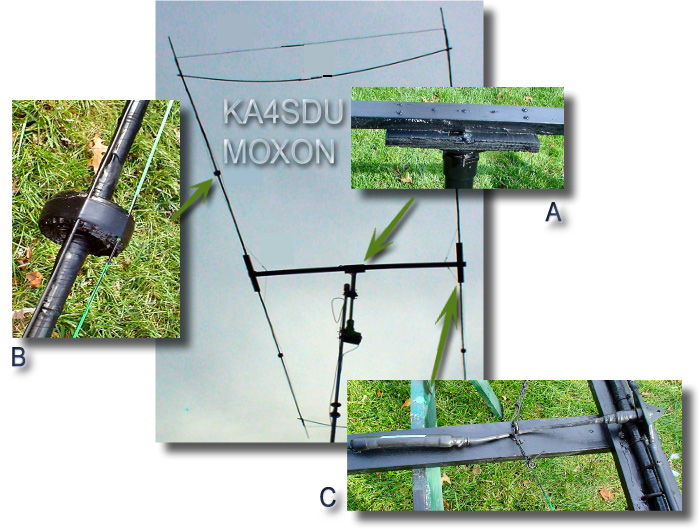"Hal's Bamboo Beast"

Unlike the "more normal" Moxon construction format using the X brace approach (which most often results in considerable drooping of the elements) KA4SDU's design was embraced as a means of keeping the Moxon in rigid conformation. To that end the # 14 wire elements were given "double duty" by using them to place tension against the length of the bamboo supporting structures. The tension thus introduced by the wire was opposed by a counter tension from ridged plastic lawn trimmer wire. In addition the "folded ends" of the moxon were also placed under tension by wooden rods bent much like a kite which forced the ends of the antenna to remain taut.
In detail B you will note the bamboo poles with a "tension donut" which forces the
antenna element
wire one way against the opposing pull of the plastic trimmer wire. The "donut"
was placed at the point where one section of bamboo pole joins with another.
These bamboo joints are made out of metal and this was also an attempt to force
the wire element away from same. These "tension donuts" are made out of half
strips of duct tape wound over and over until the element and the plastic line
are about 2.5 inches away from the bamboo poles. Item D shows one of the
termination points of the plastic line.
Detail A reflects the PVC mast as connected to the wooden boom. The antenna is "nested" at 25 feet and the support brace is used in lieu of guy wires. Using a tip from submarine service - the antenna mast is painted in splotches of earth colors to achieve some measure of stealth to blend in with the natural fauna. Bamboo was selected because by volume and weight it appears to be much more rigid that fiberglass fishing poles. The bamboo poles were wrapped with electrical tape and painted. The remaining photos depict close-up views of the "tension donut", and the wooden mast as connected to 2" PCV pipe threaded into a metal pipe termination ring/joint. Every effort was made to eliminate metal items from the construction however two metal U bolts were used for each of the four pole ends because plastic tie wraps just did not appear strong enough to keep the poles tight against the mast.
Detail C reflects shows in-line choke as connected the antenna via the Budwig center insulator.You can't see the element wires connecting to the Budwig because these wires are running inside very narrow pcv tubes so as to isolate them from the metal U bolts holding the bamboo poles and to reduce stress on the antenna junction point. These small pcv tubes are about 1' each and are held down with plastic tie wraps attached to the poles.
The antenna was designed "by the book" for 18.120. KA4SDU built it like a tank
and too this "baby" was not a dropper. His pride of design was quickly replaced
by depression when he connected his trusty Autek RF Analyst to the beam
and found the SWR to be 2.2! At that point hemade a swr plot with the Autek and
found out that his new "improved" Moxon had a SWR of 1.2
- 720 KHz below design frequency - how could this be? Anyway- using the Moxon
computer program as found on the W4RNL web site he hen designed the antenna for
18.840 which after adjustments to the elements brought the SWR down to 1.3 at
the desired frequency of 18.120 which means that his "improved" Moxen is more
than 3 percent smaller than it's brothers /
sisters. As a means of testing hisnew antenna which by now hehad named the
MBB1 (Moxon Bamboo Beast 1) he have made numerous A/B test using a very good 17M
full wave Delta Loop ( fed at the apex - about 25' above ground at the high
point. The Antenna Handbook by William Orr W6SAI contains his "Truth
Table of Antenna Gain" which reflects that the loop has a 2 Db gain over a
half-wave dipole while he list a 2 element Yagi with a 5 Db gain. Thus the
loop ( when comparing in its favored directions) is a useful "standard" for the
A/B Moxon test. My receive test after a few days reflects a consistent 1 to 2 S
unit gain using the Moxon and often the beam was many S units above the loop.
Also, the front to back is very impressive. Of course with rapid QSB on 17
meters it is certainly less than pure science to evaluate an antenna this way
and the objective can become subjective.
KA4SDU is convinced that the Moxon is much better than his loop.
However, what he is not so sure of is how his odd ball Moxon stacks up against
its longer brothers. KA4SDU's Moxon Bamboo Beast "bad boy" seems to
be doing one heck of a job for a ham who says, "to be honest, I don't know
"rats" about real antenna theory!"
Email KA4SDU "Hal" at maryannehal@hotmail.com for additional information about his MOXON.